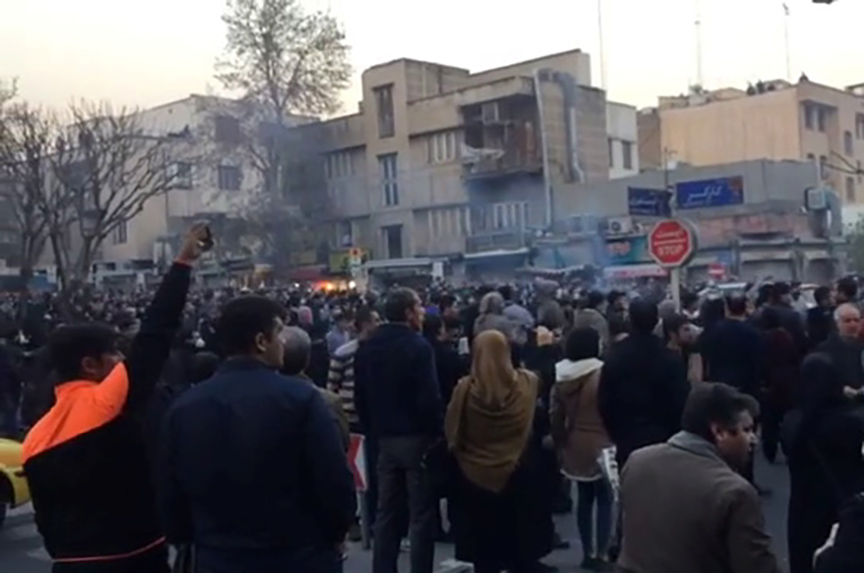 What is driving the protests that have recently rocked Iran and where is this movement headed? As an observer, rather than a political activist, I would formulate the profile of this movement—which the protesters have dubbed the “Iranian national revolution”—as follows.
What is driving the protests that have recently rocked Iran and where is this movement headed? As an observer, rather than a political activist, I would formulate the profile of this movement—which the protesters have dubbed the “Iranian national revolution”—as follows.
First, what is the nature of the Iranian national revolution?
This movement is an uprising by the poor and the middle class to protest their dire economic conditions and to oppose the Iranian regime. Its main characteristics are:
1) It is deeply nationalistic. The protesters want to save Iran from the turmoil in the country;
2) It clearly and unequivocally seeks to transform the Islamic Republic into a secular democracy based on universally accepted human rights;
3) It seeks to stop the flow of Iran’s national resources to the Gaza Strip and Lebanon, Syria, Yemen, and other countries in the region.
What are the protesters’ goals?
The protesters have three main goals:
1) Goal One: Getting back the national wealth from Iran’s Islamic Revolutionary Guards Corps (IRGC) and Supreme Leader Ali Khamenei and returning it to the people. These two entities have seized billions of dollars’ worth of Iran’s national wealth, amounting to nearly half of Iran’s GDP. The protesters want a decent livelihood.
2) Goal Two: Conducting a referendum on the future of the Islamic Republic—Yea or Nay— under the supervision of international organizations rather than this untrustworthy regime. In 1979, when Ayatollah Khomeini held a referendum on creating an Islamic Republic the people did not know the implications of such a move and got swept up in the emotional and revolutionary atmosphere of that era. Having experienced an Islamic Republic firsthand, they believe that they should be given another turn to voice their opinion at the ballot box. Only seven million of those who took part in the referendum almost thirty-nine years ago are still alive. More than seventy-three million Iranians were either children at the time or born after the vote. Various surveys inside Iran have shown that an absolute majority of the people, i.e. more than ninety percent, do not want an Islamic Republic. It is noteworthy that in practice similar dictatorships are usually overthrown first and a referendum held afterwards.
3) Goal Three: Changing Iran’s foreign policy to an independent policy that protects the interests of the Iranian people rather than following Russia and wasting national resources in the region.
How can the Iranian national revolution achieve its goals?
The protesters are following the principles of civil resistance and have adopted three types of actions:
1) Arranging mass protests in the form of marches, gatherings, writing slogans on walls, and other forms of collective protests aimed at increasing public participation.
2) Organizing a noncooperation movement, such as refusing to pay water, power, and gas bills; non-payment of taxes; boycotting the institutions and affiliate entities of the Supreme Leader and the IRGC; and calling strikes.
3) Promoting rifts within the Iranian regime and its repressive forces, and encouraging the police and eventually lower-ranking members of the IRGC to abandon the regime and join the protesters. The conventional army is already with the people. This has worried the IRGC to the point that it has appointed its own guards at weapons depots in the army garrisons. A large fraction of the police force, unlike its certain repressive units, has either stood aside or accompanied the protesters as per testimonies of witnesses and the video clips of the protests. Although the IRGC and its paramilitary force, the Basij, are the regime’s main pillars their solidarity showed signs of wavering, especially in the smaller cities, during the recent protests.
How would the transfer of power happen?
The opposition political entities agree that after the referendum on the fate of the Islamic Republic:
1) An interim government will be formed by a “transition council,” which includes activists inside and outside Iran. Fortunately, there is a promising consensus among the prominent political opposition figures to cooperate on civil resistance, hold the referendum, and accept its results.
2) An interim government will hold elections for a Constitutional Assembly and the representatives of the people therein will be mandated to draft and adopt a new constitution formulated on the basis of secular democracy and universally accepted human rights.
3) The interim government will entrust power to a government that is legally elected under the new constitution.
The recent protests are just the beginning of the end in Iran. It may take several months, but the main concern now is how to ensure a smooth transition from a theocracy to a secular democracy.
Mohsen Sazegara is president of the Research Institute on Contemporary Iran (RICI) and a political activist.
Image: Anti-government protesters are seen in Tehran, Iran, on December 30 in this still image from a video obtained by Reuters.
